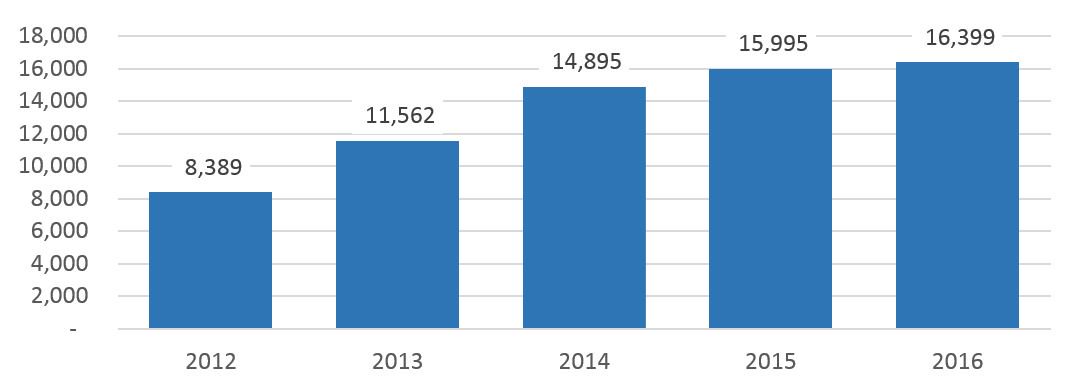Comptroller Stringer: New Data Shows Impact Of DOMA Repeal

Comptroller analysis shows same sex marriage in New York City has nearly doubled in five years
New data comes as White House pledges to end questions of sexual orientation and gender identity in the 2020 Census
(NEW YORK) – New York City Comptroller Scott M. Stringer today released a new policy brief regarding same-sex marriage in New York City that spotlights how the repeal of the Defense of Marriage Act – or DOMA – has affected New York City.
“What this data shows is that laws matter, that equality matters, and that ending DOMA once and for all has made a difference in the lives of New Yorkers. We must continue to be the most progressive city in the world, and our commitment to fairness is never going to change,” said Comptroller Scott M. Stringer. “This is the first-ever analysis of census data regarding same sex couples in New York, yet it comes as the President wants to turn back the clock by ending questions on sexual orientation and gender identity in the census. Just when more data is needed, and when we need more numbers to study, Washington wants to eliminate these critical questions. It’s the wrong thing to do, and it will make it harder to do important analyses like this one. But no matter what, we’re going to keep running the numbers and putting out the data that New Yorkers need.”
According to new American Community Survey data analyzed by the Comptroller’s Office:
- Same sex married couples in the City have grown from approximately 8,000 in 2012 – after New York State passed the Marriage Equality Act – to more than 16,000 in 2016 following historic Supreme Court decisions that repealed DOMA. That is an increase of nearly 100 percent over this 5 year period.
- The biggest increase in marriages occurred in 2014, a 28 percent jump, following the landmark Supreme Court decision (United States vs. Windsor) in June 2013 that effectively recognized same sex marriages for federal purposes.
- Overall, the numbers of same sex married couples in the City are still small, only 16,399 in 2016 compared to over 1.1 million opposite sex couples. This can be partly explained by the relative newness of same sex marriage, and could illustrate the devastating impact that the AIDS epidemic had on older cohorts.
The Number of Same Sex Married Couples Has Nearly Doubled in 5 Years

Source: Office of the Comptroller calculations from ACS 2012-2016 1-Year Estimates
The new data also provides socioeconomic characteristics of same sex married couples. For the City as a whole, the median income for same sex married couples was higher than those for opposite couples, at $145,000 compared to $87,000 respectively. That can partly be explained by the higher prevalence of two-earner households – 60 percent for same sex married couples versus 45 percent for opposite sex couples. Same sex married couples generally earn similar incomes compared to opposite sex couples when controlling for borough of residency.
Same- and Opposite-Sex Married Couples by Borough
| Same Sex | Opposite Sex | |||
| Number | Median Income | Number | Median Income | |
| Bronx | 920 | $60,000 | 142,046 | $62,200 |
| Brooklyn | 5,817 | $142,500 | 341,235 | $76,000 |
| Manhattan | 6,632 | $145,300 | 207,007 | $160,000 |
| Queens | 2,574 | $97,300 | 338,506 | $82,000 |
| Staten Island | 456 | $145,000 | 90,059 | $105,000 |
| TOTAL | 16,399 | $145,000 | 1,118,853 | $87,000 |
Source: Office of the Comptroller calculations from ACS 2016 1-Year Estimates
The new policy brief comes after a June 2017 survey of LGBTQ New Yorkers from Comptroller Stringer’s Office. That report found:
- Overall, 21 percent of survey respondents indicated that they believed they had been denied a promotion at a job, not hired for a job they applied for, or fired or forced to resign from a job due to their sexual orientation or gender identity.
- Roughly 47 percent of survey respondents indicated that they believed they had been denied equal treatment or services or been verbally or physically harassed in public spaces as a result of being LGBTQ.
- A full 42 percent of respondents who identify as transgender or gender non-conforming indicated they were denied a promotion at work, not hired, or forced to resign.
The Comptroller’s policy brief today comes from data from the U.S. Census Bureau’s American Community Survey. The Trump Administration recently withdrew questions proposed by the Census Bureau on sexual orientation and gender identity in the 2020 decennial census.
To read the full policy brief, click here
###